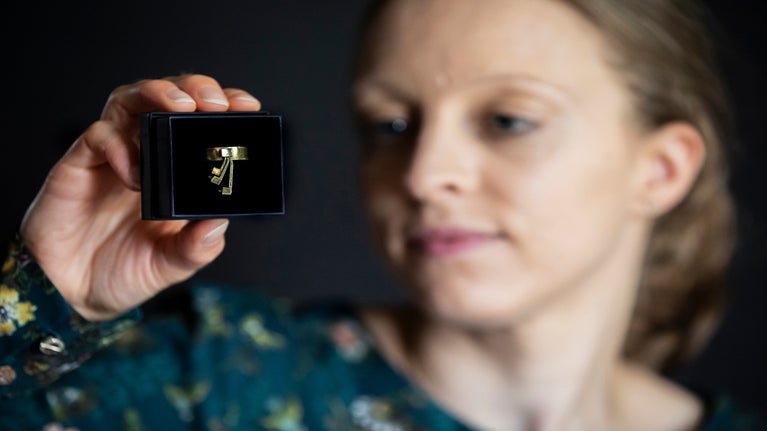Striking jewel by ‘creator of genius’ to royalty and film stars returns to historic house where it was made

A gold and diamond ring made by Louis Osman, a leading figure in 20th-century design, has gone on public display at the Northamptonshire home where he lived, worked and drew inspiration for more than a decade. Osman is best known for designing and making the coronet worn by the then Prince of Wales at his investiture in 1969.
The National Trust acquired the ring and an accompanying drawing for Canons Ashby, near Daventry, at auction late last year.
The Tudor manor house was the ancestral home of the Dryden family for 400 years, but between 1968 and 1980 the architect turned goldsmith Louis Osman was a tenant there. He had first visited Canons Ashby in 1935 and named “the historic house and its environment” as the principal motivation behind his decision to live and establish a workshop there three decades later. Workshops were set up in the old servants’ quarters and one part of the house was set aside for working with gold leaf. The bath next door was regularly filled with cyanide, used to extract gold from ore.
The place provided huge visual and creative inspiration for his work. “Mass production does not particularly interest me,” he said. “I feel that what I do should have its roots in the past but should be completely modern and of today.”
Osman fulfilled a series of major commissions while living at Canons Ashby, notably the Prince of Wales’s Investiture Coronet; and a showcase for the Magna Carta, a gift from the British government to commemorate the 200th anniversary of American independence in 1976. On one occasion actor and jewellery collector Elizabeth Taylor visited Osman at Canons Ashby, and “bought what I’d got made”.
Cultural Heritage Curator Rebecca Harvey said: “It’s rare to have the work of an artist and craftsman that was created at a National Trust place.
“The Trust has a small Osman collection, but until now it hasn’t owned any examples of his jewellery. With this acquisition, we’ve been able to significantly broaden the scope of our overall jewellery collection, especially given its striking modern design.
Rebecca continued: “As the place primarily associated with Louis Osman’s career, Canons Ashby can be regarded as one of the great precious metal design and producing centres of the 20th century and has a special place within British design history.”
He is known to have undertaken deep historical research before expressing his ideas in contemporary and highly imaginative creations, and the pieces he designed and made while at Canons Ashby are regarded as some of the most extraordinary and innovative works in gold and silver of the mid-20th century. Graham Hughes, Art Director of the Goldsmiths’ Company from 1951–1980, described Osman as “a creator of genius” whose talent had “the power to excite an almost spiritual appreciation.”
The newly acquired ring was made in 1970 for his daughter Marie-Louise, who also lived at Canons Ashby. It features a stylised ‘tassel’ of three bars, each ending in a cube inset with a faceted diamond, and has the hand-made, textured surface finish that Osman preferred. In 1974, it was part of an exhibition held in Canons Ashby’s Long Gallery to celebrate Osman’s work and promote the restoration of the house. The investiture coronet was one of the star attractions.
The ring will be displayed in the Painted Parlour – which Osman used as his sitting room – alongside his original design drawing in pen and watercolour, also acquired recently by the Trust, from Thursday 29 August. Osman’s design drawings, often accented with gold leaf, have long been valued as works of art in their own right.
The ring goes on show as part of a wider ‘Lost and Found’ display, which explores how collection items have come to be in the house over time. The display continues until summer 2025 (excl. Christmas closure).
For further information and opening times visit www.nationaltrust.org.uk/canons-ashby